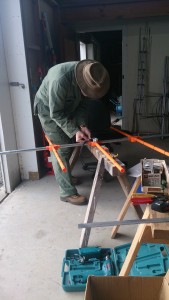Okay, so the Perseid meteor shower has passed and I didn’t detect as many meteors as I expected, so I did a little bit of an internet search and found that the Perseid meteor shower is actually a Northern Hemisphere shower. The radiant (the point from which meteors seem to originate from) doesn’t get as high up in the sky for us and thus the Southern Hemisphere does not get as many meteors. On top of that, they were coming from the North, while my antenna is pointing South so this seems to explain why I detected no difference in my meteor count.
However, I found a website which gives a list of meteor showers for the Southern Hemisphere, so I will be referring to this from now on and see if what I am getting is matching with what is written here.
Now, how do I know that my radio signal is reflecting off a meteor trail?
According to the research paper, “Forward scattering of radio waves off meteor trails, 1995” by Jean-Marc Wislez, in classical theory of meteor scatter, there are two extreme cases of meteor trails that can occur – the “underdense” meteor trail and the “overdense” meteor trail. When a meteoroid enters our atmosphere, the atoms in the atmosphere become ionised, thus creating a trail of free electrons and ions. It is the free electrons that contribute the most to the scattered signal. If the line density (i.e. the number of electrons per unit of length of the meteor trail) of ionisation is low, then the incident wave penetrates the meteor trail and the electrons absorb the energy of the wave. This makes them oscillate and thus they re-emit the radio wave in all directions. The radio signal that is scattered in this way is said to have scattered off an “underdense” meteor trail. If the line density of ionisation is high, then we assume that the meteor trail acts like a metallic cylinder whose radius is much larger than the wavelength of the radio wave. This approximation assumes that the incident waves scatter off the surface of the cylinder since the radio waves cannot penetrate the central part of the trail. This type of trail is called an “overdense” meteor trail. However, the “metallic cylinder” approximation has flaws, as it does not take into account any low density part of the meteor trail, and it assumes that the power of the scattered signal in the perpendicular direction to the meteor trail is directly proportional to the radius of the cylinder.
Here is a simulation of a power-time graph, based on theory, of an underdense and a short overdense meteor trail (taken from the “Forward scattering of radio waves off meteor trails” paper):

Power-time graph of an underdense and a short overdense meteor trail. Reference: Forward scattering of radio waves off meteor trails – Jean Marc Wislez
And here are examples of some of my observations:
As it can be seen in the graphs, the power-time graphs of the underdense and short overdense meteor trails almost perfectly match the predicted simulations. The only difference is that some of the fluctuations that I got could be due to the signal itself as I am using an FM radio signal, whereas in the research paper they used a constant amplitude signal. However, these signals are both quite short so I think it’s safe to assume that in these two moments the signal was very close to being constant in amplitude and thus they seem to fit the theory.
Now, there is also a third type of power-time graph that can happen, and this meteor trail is called a long overdense trail. In the research paper that I keep referring back to, there isn’t a simulation to predict this type of meteor trail, however it was detected and this is the observation that they made:

Power-time graph of a long overdense meteor trail. Reference: Forward scattering of radio waves off meteor trails – Jean Marc Wislez
And here is an example of a long overdense signal that I detected. As it can be seen,
all three types of graphs seem to fit predictions or observations that have already been made and thus I conclude that what I am detecting really are meteors. The only one that is difficult to say that it was reflected off a meteor trail for sure is the long overdense meteor trail as it lasts much longer than the others, and thus the signal itself can fluctuate in power as it is an FM radio signal. It is very difficult to remove the actual signal fluctuations to compare to the long overdense meteor trail observation.
I should also point out that these examples I showed are the “perfect” examples I found. There are signals that I have detected whose power-time graphs aren’t exactly as what is predicted, but still follow the similar patterns. The variations in the graph could be due to the fact that my signal is not constant in amplitude, but also these simulations count on ideal conditions and make approximations and assumptions that do not always happen in real life. Meteor trails can be in any size and shape, depending on the size of the meteor, its speed, direction and also wind, therefore the radio wave reflections can be quite different from these ideal predictions.







